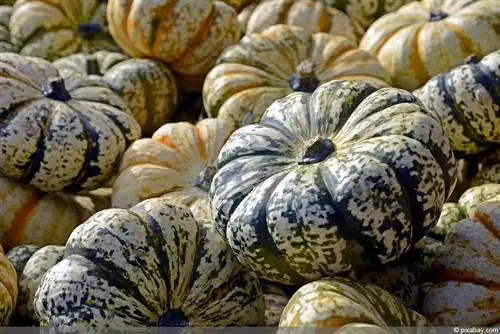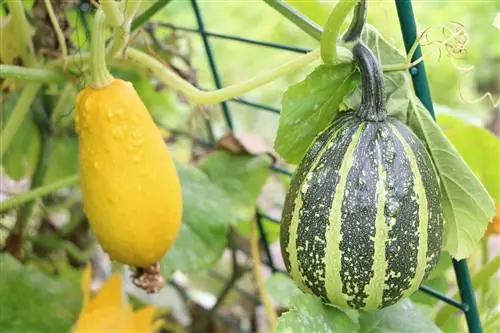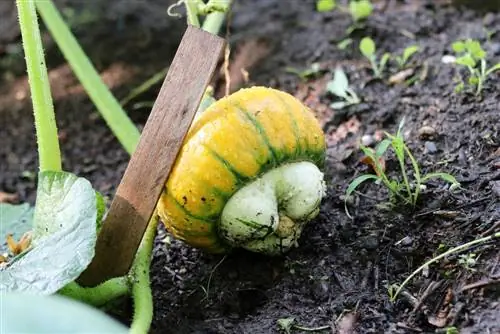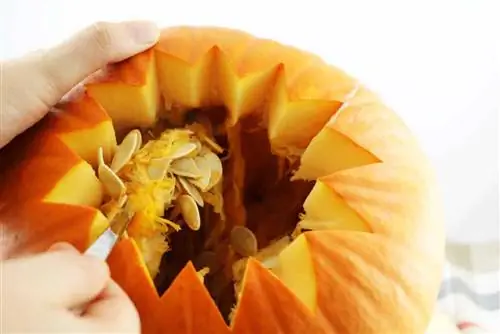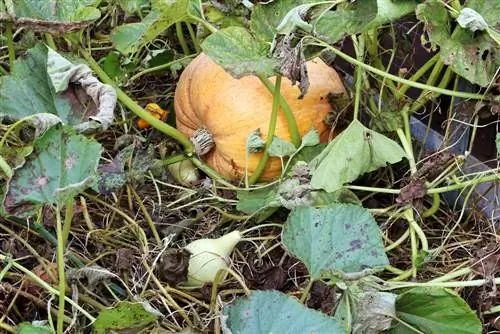- Author admin [email protected].
- Public 2023-12-17 03:39.
- Last modified 2025-01-24 12:45.
In autumn, an ornamental pumpkin is a wonderful decorative element that brings a lot of warmth into every apartment. But what do you do if you don't have enough space in the garden to be able to cultivate these visually attractive pumpkins in the summer? Then it's best to grow it in a plant pot or planter. The maintenance effort is kept within very narrow limits.
ornamental pumpkin
Ornamental pumpkins are not intended for consumption. Although you could definitely eat many varieties, it doesn't make much sense because of the small amount of pulp. In addition, there are also varieties that can cause significant stomach cramps because of their bitter substances. As the name suggests, these pumpkins are primarily grown for their appearance anyway. Varieties whose fruits do not grow too large are particularly suitable for cultivation in pots or buckets. These include, among others:
- Autumn Wing, fruit size 10 to 15 cm
- Flat Striped, fruit size 5 to 10 cm
- Gourd Verruqueuse, fruit size 8 to 12 cm
- Mini ball, fruit size 5 to 8 cm
- Pear Bicolor, fruit size 7 to 10 cm
- Shenot Crowns: fruit size 10 to 15 cm
These varieties all have different fruit shapes and color shades. The shell can be smooth as well as jagged or uneven. What they all have in common is that they are heavy feeders, meaning they need an extraordinary amount of nutrients in order to grow and produce magnificent fruits.
Note:
In addition to the size of the fruit, the number of fruits also plays an important role when cultivating in a pot. Except for Flat Striped (up to 20 fruits), the yield varies between six and twelve fruits.
Seeds
Ornamental pumpkins are usually grown from seeds in pots. Seeds for the individual varieties are available from garden retailers for relatively little money. Ideally, seeds are initially sown in smaller pots. Pots with a diameter of six to ten centimeters are initially completely sufficient. It is best to use a very humus-rich potting soil as a planting substrate, which provides the seedlings with the necessary amount of nutrients. The perfect time for sowing is late spring, around mid or late April. This is exactly how you should proceed:
- Fill the pots loosely with the potting soil
- Press two seeds loosely into the soil per pot
- pour well
- Move the pots to a light-flooded location
- pay attention to a temperature of 20 to 25 degrees Celsius
- Always keep soil moist
After around three to four weeks, the seedlings should have developed several pairs of leaves. Then you can move the young plants into a larger planter.
Tip:
Always sow the purchased seeds in the year of purchase. Since fresh seeds develop best, you can experience bitter disappointment a year later.
Plants
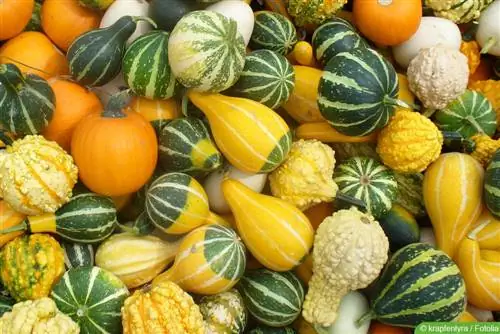
Before you start putting the young plants in the larger container, you should think about the size of the container you need and the future location. It is always important to remember that pumpkin plants can grow very large and grow wildly. In addition, the fruits also require space. The plant pot should therefore have a capacity of at least 60 to 90 liters. In addition, a climbing aid should be integrated right from the start. It also makes sense to immediately place the pot on a plant trolley - this will make transporting the heavy container much easier later. The ideal planting substrate is a typical vegetable soil with a very high compost content. You should proceed as follows:
- create a drainage made of pottery shards over the bottom opening in the bucket
- spread a fleece over the drainage that is permeable to air and water
- Fill in plant substrate
- dig a small depression in the middle
- Insert the strongest of the two young plants from the small pot into the hollow
- Press the soil lightly and water well immediately
So that growing the ornamental pumpkins is really successful, the plant pot should first be moved to a place protected from the wind and in partial shade. It then remains there for eight to ten days. A spot on the balcony is usually ideal for this. It can then be placed in its final location. This location should definitely be extremely sunny. There should also be some space next to the pot where the fruit can rest if necessary.
Care
Growing ornamental pumpkins is also attractive because they don't require much care. They get along quite well without constant attention. However, it is important to water them regularly. It is advisable to keep the area around the roots well moist at all times. You should also add compost every now and then as a natural fertilizer in the summer months. If you want to work the fertilizer into the soil, you need to be extremely careful, as the ornamental pumpkin has very sensitive roots that can be easily damaged. Tendrils and leaves must be loosely attached to the trellis or trellis from time to time.
Harvest
Ornamental pumpkins grow throughout the summer and into early fall. The fruits can usually only be harvested in the second half of October. The harvest should definitely take place before the first frost. Cut off the stem generously with a sharp knife. It is important not to damage the fruit even when harvesting, as this will significantly affect its storage life. The fruits should be stored at a temperature of ten to twelve degrees Celsius. They are therefore more suitable as decoration for a staircase and have no place in the heated living room.

